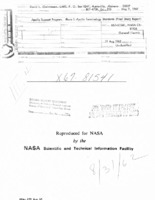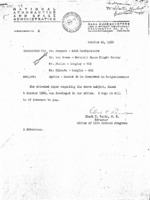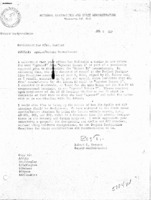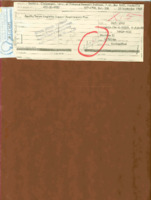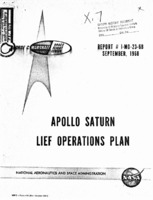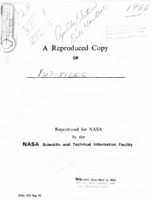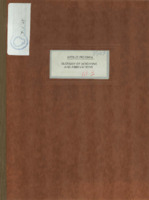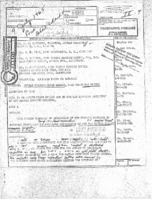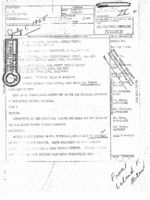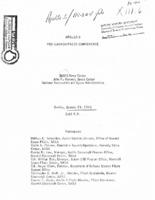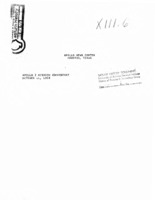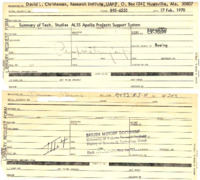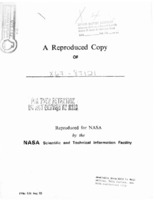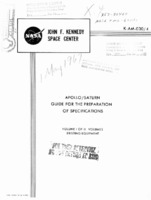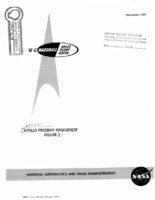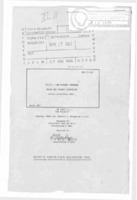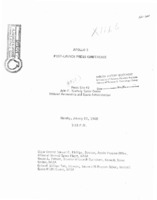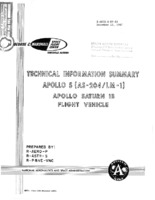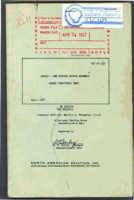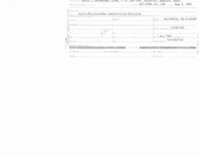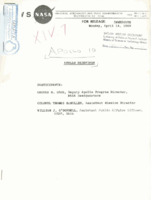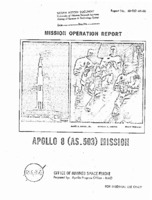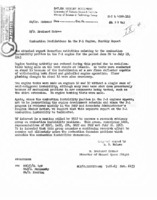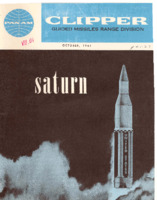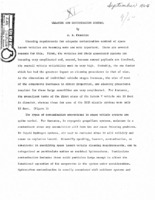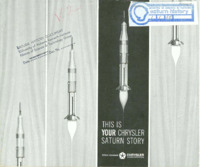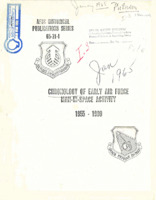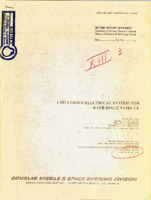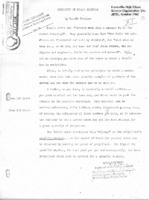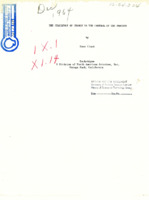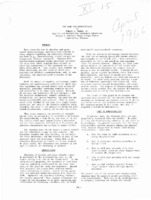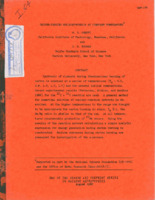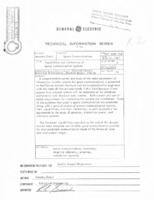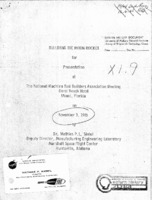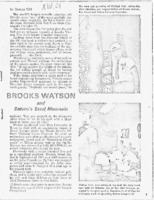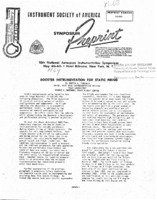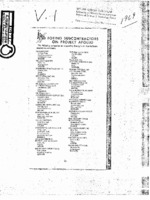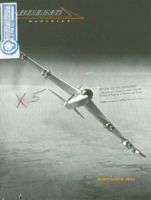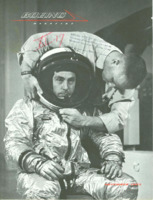
Browse Items (970 total)
Sort by:
-
Apollo Support Program: Phase 1: Apollo Terminology Standards Final Study Report.
From the abstract: "This report concludes the Phase 1 study activities of the requirements for terminology standardization of the Apollo Integration Support Program. A review is made of the studies conducted and the findings resulting from these activities. Conclusions are drawn and recommendations are made for a proposed Apollo Terminology Handbook. An implementation plan for producing and maintaining an Apollo Terminology Handbook is included. A sample of such a terminology handbook is produced as Part 2 of this report." -
Memorandum to Dr. Seamans, Dr. von Braun, Mr. Donlon, and Mr. Gilruth.
The memorandum contains a paper titled, "Apollo - Should It Be Committed to Weightlessness." This paper contains information about artificial gravity and the effects of prolonged periods of weightlessness on human beings and chimpanzees. -
Memorandum for Dr. Mueller from Robert C. Seamans.
This memorandum details changes or changes to be considered in Apollo-Saturn nomenclature. It also contains the matter of the Apollo and AAP missions designs and changes Seamans wishes to see. -
Memorandum to update the "Apollo/Saturn Logistics Support Requirements Plan."
This memorandum contains the pages to be changed in the logistics program for the Apollo/Saturn Project. The logistics plan includes the design, procuring, manufacturing, and production processes. This plan formalizes the program, improves logistic support, and implements management and action plans. -
"Apollo Saturn LIEF Operations Plan."
This paper identifies the support functions performed by MSFC through the Launch Information Exchange Facility (LIEF) during the Apollo Saturn Mission Operations and other facilities required to carry out these functions. It also identifies mission specific documents required for operation. Note that page 20 is missing. -
The "Apollo/Saturn Data Handbook."
According to the preface, "This handbook provides KSC management personnel with general information relative to the Apollo-Saturn program. Emphasis is placed on Saturn launch facilities and related support equipment. Saturn vehicle parameters are included for general information. -
"Apollo Program: Glossary of Acronyms and Abbreviations."
This glossary contains acronyms and abbreviations commonly found in documentation from the Apollo Program. This glossary is meant to be a tool for historians and other researchers. -
Telegraphic message containing an Apollo Program Flash Report.
This message for the Apollo Program Director contains a report of the Apollo launch vehicles, problem that occurred, and actions required. The photocopy is difficult to read. -
Telegraphic message containing an Apollo Program Flash Report.
This message for the Apollo Program Director contains a report of the Apollo launch vehicles, problem that occurred, and actions required. The photocopy is difficult to read. -
"Apollo 5 Pre-Launch Press Conference."
This document contains a transcript of the pre-launch conference, including the questions asked and the answers given by participants William C. Schneider, Rocco A. Petrone, George M. Low, Col. William Teir, Col. Royce Olson, Christopher C. Kraft, Jr., and Eugene F. Kranz. -
"Apollo 7 Mission Commentary."
This document contains the transcript from the Apollo 7 mission. This transcript contains the communication from the first seven days of the ten day mission. -
"Apollo Logistics Support System (ALSS) Payloads Summary Report."
This report includes a summary of the major tasks performed by the Apollo Logistics Support System Payloads with an emphasis on the Lunar Mobile Laboratory (MOLAB). -
The "Apollo/Saturn Guide for the Preparations of Specifications: Volume II of II Volumes."
This reproduced copy contains 43 pages of "general instructions for the uniform preparation of Project, System, and Contract End Items Specifications for Apollo/Saturn new equipment and major refurbishment." -
"Apollo/Saturn Guide for the Preparation of Specifications: Volume I of II Volumes."
According to the purpose found in section 1.1, "Volume I provides a guide for the preparation of specifications for existing equipment in the Apollo/Saturn Program." -
"Apollo Program Management Volume 3."
According to the introduction found on page ii, this document was created to detail the "MSFC segment of the total Apollo Management process and to describe the methodologies and techniques currently being implemented." -
"Apollo-LEM Docking Combined Probe and Drogue Assemblies Static Structural Test."
This document contains the test technical report and results for the LEM docking probe and drogue assemblies to demonstrate that the assemblies would sustain enough load to capture latch. The document contains various graphs, diagrams, and images from testing. The final page contains a note that page no. A-139 is missing from the report. -
"Apollo 5 Post-Launch Press Conference."
This document contains the transcription from the Apollo 5 post-launch press conference, including all the questions asked and answers given by participants Major General Samuel C. Phillips, Rocco A. Petrone, and Colonel William Teir. -
Technical information summary of the Apollo Saturn 1B flight vehicle.
According to the summary found on page 1, this document "presents a brief and concise description of the AS-204/LM-1 Apollo Saturn Space Vehicle." The information within the document allows readers to follow the timeline of the space vehicle's lift-off and journey to space. -
"Apollo 4 Pre-Launch Press Conference."
This document contains a transcription of the pre-launch press conference for Apollo 4. It includes the questions asked and answers given by participants Dr. Robert C. Seamans, Dr. George E. Mueller, Major General Samuel C. Phillips, Dr. Kurt H. Debus, and Dr. Wernher von Braun. -
"Apollo - LEM Docking Drogue Assembly Static Structural Test."
This document contains the tests and test results from structural tests performed on the Apollo LEM docking drogue assembly between January 11, 1967 and February 15, 1967. The document contains various graphs, diagrams, and images pertaining to the tests. -
"Apollo Documentation Administration Instruction."
According to the foreword found on page i, this document includes instructions on "procedures, methods and practices...necessary for the effective management of a program documentation system." -
Briefing for Apollo 10.
This document contains a transcript of the briefing meeting for the launch of Apollo 10. Participants include George H. Hage, Colonel Thomas McMullen, and William J. O'Donnell. -
Apollo 8 Mission Operation Report.
This report is meant to provide NASA Senior Management with information on flight plans, mission objectives, and the basis for assessment of mission accomplishment. Note that page 61 is missing from the report. -
Combustion oscillations in the F-1 engine, monthly report.
The set of documents includes an introductory letter written by D. Brainerd Holmes and Tischler's report with the subject "F-1 Combustion Instability Report for Associate Administrator; Period June-July 1963." -
Guided Missiles Range Division Clipper, vol. 2, no. 3, October 1961.
The Clipper is a Guided Missiles Range Division, Pan American World Airlines, Inc., internal publication. This issue includes the articles "News at a Glance," "The Big One," "New Ships on the Horizon," "Civic Responsibility," "Picture Highlights," "Service Awards," "September Service Pins," and "Recognizing Credit Union." "The Big One" includes details about Pan Am's role in developing the Saturn booster. -
"Cleaning and Contamination Control."
The document is a paper describing contamination cleaning methods and advocating for further developments in the field. Tables and figures are included at the end of the paper. The figures include a comparison of Saturn V with Saturn I and Saturn IB and cross-sections of the Saturn C-5, S-IC stage fuel tank assembly and oxidizer tank assembly. -
"This is Your Chrysler Saturn Story."
The document is a booklet created as part of the NASA/Chrysler Corporation Space Division manned flight awareness program. It discusses Chrysler's role in manufacturing and testing the Saturn and includes photographs and diagrams of Saturn stages, operations at Michoud, testing, and future missions. The section headings included in this booklet are "Chrysler and the Saturn," "Saturn at Michoud," "The Voyage of Saturn," "Saturn Firings," and "Saturn's Missions." -
"Chronology of early Air Force man-in-space activity: 1955 - 1960."
The foreword states "In this chronology, Air Force manned space flight activity is viewed from the perspective of the ballistic missile development agency - the Air Research and Development Command's Western Development Division, later re-named the Air Force Ballistic Missile Division. Due to resource limitations at the Space Systems Division historical office, research for this chronology has been generally limited to materials available in the files of that office. All documents cite in the notes which follow each entry are located in the archives of the Historical Division, Office of Information, Space Systems Division, in Los Angeles California." There are handwritten notes throughout. -
"Chilldown Electrical System for S-IVB Space Vehicle."
The paper is marked, "To be presented at the IEEE 1965 Aerospace Conference featuring Flight Vehicle Electrical/Electronics Systems, Houston, Texas, June 20-24, 1965." The abstract states "This paper presents the electrical system used to drive the chilldown motor pumps on the S-IVB space vehicle. This system consists of a 56 volt battery supplying power to the two three-phase solid state inverters which in turn drive two cryogenic motor pumps. Included in this paper is a short description of the overall chilldown system requirements. The advantages of the a-c system over the d-c system are discussed with emphasis on weight and reliability. Two functionally identical 1.5kva inverters were designed. One inverter uses germanium transistors in the output stage while the other uses silicon transistors. Both inverters were designed to have a quasi-square wave output. The inverter circuitry is described and the advantages of each is discussed including a comparison of weight, size, operating temperature, efficiency and voltage rating." Includes diagrams. -
"Chemistry in Space Boosters" presentation given at Huntsville High School.
The document is a draft of the presentation "Chemistry in Space" by Harold Perkins, who explains the role of chemists in developing space launch vehicles. The document Includes references to charts and other presentation supports. The document is marked in the upper left hand corner "Huntsville High School Science Organization (the JETS), October 1962." -
"The Challenge of Change vs the Control of the Process."
The introduction states, "This paper is designed to present the Rocketdyne engine program as it applies to the Saturn launch vehicles and will apply to the Apollo program of manned flight to the moon (Fig. 1). The vehicle that will launch this flight is the Saturn V, the largest and most powerful of the Saturn family. This vehicle, 362 feet tall and 33 feet in diameter, will be capable of sending a 45-ton payload to the moon or placing a 120-ton payload in earth orbit. Five F-1 engines power the first stage of the Saturn V; five J-2 engines, the second stage; and one J-2 engine, the third stage. The thrust of the first-stage engines alone will be equivalent to 160 million horsepower. Both of these engines, the F-1 and the J-2, were designed at, and are currently being produced by Rocketdyne." -
"The Case for Compatibility."
"The Case for Compatibility" is a paper by Robert L. Smith, Jr., who worked in Quality and Reliability Assurance Laboratory at George C. Marshall Space Flight Center. The summary states, "Ever since the use of missiles and space launch vehicles began, questions have existed in every program regarding the similarity between upstream (e.g., manufacturing, static firing ) and launch site checkout equipment. Programs have existed which utilized nearly identical equipment for both uses; other programs have existed in which any resemblance of the equipment was probably coincidental. Many factors have entered the final decisions, not the least of which were economic and schedule considerations, and, in some instances, the organizational structure of the developer." -
"Carbon-Burning Nucleosynthesis at Constant Temperature."
"Carbon-Burning Nucleosyntesis at Constant Temperature" is part of the Orange Aid preprint Series in Nuclear Astrophysics, August 1968. The abstract states "Syntesis of elements during thermonuclear burning of carbon is examined at a series of temperatures (T=0.6, 0.8, 1.0, 1.2, 1.4) and for several initial compositions. Recent eperimental results (Ptterson, Winkler, and Zaidins 1968) for the 12C+!@C reaction are used. A general method for numerical solution of nuclear-reaction networkds is described. At the higher temperatures in the range now thought to be appropriate for carbon burning in stars, -
"Capabilities and Limitations of Space Communication Systems."
The paper "Capabilities and Limitations of Space Communication Systems" is part of a General Electric Technical Information Series prepared for the Apollo Support Department. The abstract states "A survey and study of the basic parameters of information transfer systems for space communications is presented in this paper, to familiarize systems checkout and on communication engineers with the state-of-the-art and trends in this field. Both current and anticipated requirements for space communication systems are briefly considered. Some of the problems that exist in space communication are presented, along with a general review of current communication systems, their capabilities, and limitations as well as possible improvements in the areas of spacecraft directional antennas, ground stations and antennas, spacecraft transmitter power, and telemetry systems. It is concluded that the increased capabilities expected by the end of this decade should make adequate and reliable space communication possible for most predicted communication needs of future space missions at lunar and near-planet ranges." -
Draft of "Building the Moon Rocket."
"Building the Moon Rocket" was presented at the National Machine Tool Builders Association Meeting, Doral Beach Hotel, Miami, Florida on November 3, 1965 by Dr. Mathias P.L. Siebel, the Deputy Director, Manufacturing Engineering Laboratory. There are handwritten notes throughout. -
"Brooks Watson and Saturn's Steel Mountain."
Included are a copy of page 7 of the December 1963 publication of Pan Am (GMRD) Clipper magazine and a letter from Pan American World Airways to David Christensen. The magazine article briefly describes the gantry that surrounded Saturn-V and Pan American's Saturn complex Supervisor, Brooks Watson. -
Booster instrumentation for static firing.
The document is an Instrument Society of America Symposium Preprint of the "Booster Instrumentation for Static Firing" by Marin A. Ferrario. "Booster Instrumentation for Static Firing" was included in the 10th National Aerospace Instrumentation Symposium which occured from May 4th - 6th at the Hotel Biltmore in New York, NY. -
Boeing Subcontractors on Project Apollo.
The document is a list of Boeing subcontractors on Project Apollo including contractor locations, projects, and funding. -
Boeing Magazine, vol. XXXIV, no. 9, September 1964.
The magazine includes the articles "Next Stop: Mars", "Up the river to the Moon", "Air Force Tests New Missile", "Shake Well Before Using", "Quick Cargo Cash", "New Heart for the B-52", "What-Next Man", "Mostly on Time", and "Faster Inspector". Also included is a briefing of events in the Boeing Company. -
Boeing Magazine, vol. XXXIII, no. 11, November 1963.
The magazine includes the article "Saddle the Dragon", "The 100 Secondsof 27 Charlie", "Which Alloy is Best?", "How to Knock Out an ICBM", "Inner Test for Outer Space", "Air Guards Get More 97s", "New Beauty Salon for Jets", "Builder Blue", "A Feel for the Wind", and "Instant Money". Also included is a briefing of events in the Boeing Company.
